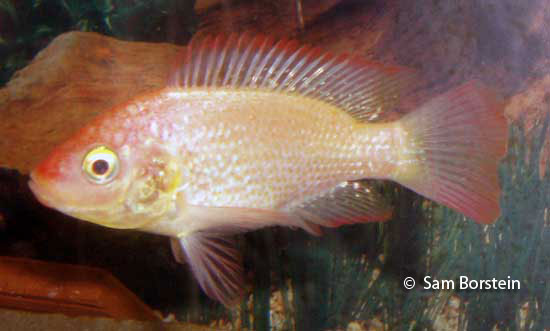Oreochromis mossambicus
(Peters, 1852)
Mozambique Tilapia, Mozambique Mouthbrooder
Synonyms: Tilapia mossambicus

Above: A male Oreochromis mossambicus of the red morph. Photo by Sam Borstein.
Etymology:
Genus- Oreo= of mountains (Latin), chromis= a fish, perhaps a perch (Greek).
Species- mossambicus= named after Mozambique, where it is found in the Zambezi River.
Intro:
Oreochromis mossambicus is not that bad looking for an Oreochromis. This fish was first typed by Peters in 1852, with the type locality found in the Zambezi River in Mozambique. This mouthbrouder is amazing and is an easy BAP. This fish can be abused and is almost impossible to kill. It's amazing what this fish an go through and still prosper. That is why it is a popular fish with fish farmers as they grow fast under any condition and get large. This is one of the most popular species for aquaculture.
Oreochromis mossambicus comes in 2 forms:- Black- rarely found in the hobby.
- Red/Gold- popular in the hobby.
Tilapia are amazing fish. They will eat anything and will breed under difficult circumstances. This fish can live in very low oxygenated waters, thrive in widely ranging of pH, and will survive in temperatures from 40 degrees to 110 degrees Fahrenheit. Because of this, Tilapia that are introduced into non-native waters cause great damage to the native fish fauna.
Distribution:
Oreochromis mossambicus is native to East and South Africa and is primarily found in the Zambezi River in Mozambique. There are introductions of this species all over the world, where they cause environmental issues. Oreochromis mossambicus has been found living and reproducing in full sea water environments (Lamboj, 2004)
Size, Maturity, and Sexual Dimorphism:
Size: Males- 18 inches, Females- 14 inches
Maturity: 2 inches
Sexual Dimorphism: Males are larger than females and show more red on the body and in the fins. Larger males also get a ducklike bill shape to their mouth.

Above: A female Mozambique Tilapia. Photo by Rick Borstein.
Care:
This fish is easy to keep. Like many Tilapia species, it is difficult to kill. I had my heater stick, the tank got up to 88 degrees F and they still did fine. Then I forget to put a heater in and it went down to 64 degrees. Again, the fish prospered. The fish isn't overly aggressive, but does get large, so take that into consideration.
As far as tank mates, they can be put with almost anything. Larger mbuna and haplochromines work well. It also makes an excellent dither/target fish for Central American species.Diet:
This fish eats anything and I mean anything. I've seen them eat their own crap. What is amazing is they can do that, and still grow. Any type of flake works well, just feed something that will stick to their bones because the fish as they have a ridiculously high metabolism.
Breeding:
If you can't breed this fish, you have all of one sex. I kept my trio in a community tank and everything worked well. My fish were about 2.5 inches and bred a week after I got them. The female held about 14-16 days and small females hold up to 200 eggs, large ones, a foot or more 1,000+ eggs!
The fry are small, but are easy to raise. They eat anything and grow at an unearthly rate. By two weeks they were an inch long.
Conclusion:
This fish is an easy BAP and a hobbyist's fish. If you like pretty show tank fish, this is not for you. If you have pike cichlids or other predatory fish, pick up a pair or trio as they have a lot of fry and they make good feeders.
References:
- Lamboj, A. (2004). The Cichlid Fishes of Western Africa. Bergit Schmettkamp Verlag, Bornheim, Germany, 255 pp.
